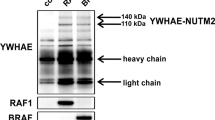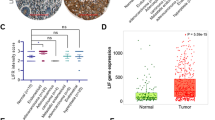Abstract
Recently we showed an integral epidermal growth factor receptor (EGFR)–E2F3a signaling path, in which E2F3a was found to be essential in EGFR-mediated proliferation in ovarian cancer cells. The present work evaluates the clinical relevance of this novel axis and of E2F3a itself in a large set of 130 ovarian cancer specimens. For this purpose E2F3a and its counterpart, E2F3b, were measured by RT–PCR and activated EGFR was assessed by immunohistochemistry. When compared with healthy control tissue, both E2F3 isoforms were overexpressed in the cancers, but only E2F3a expression correlated with tumor stage (ρ=0.349, P=0.0001) and residual disease (ρ=0.254, P=0.004). Univariate survival analyses showed E2F3a and activated EGFR to be associated with poor PFS and OS. Furthermore, a strong, positive correlation between activated EGFR and E2F3a expression was shown (P=0.0001). We further identified two EGFR-independent mechanisms that regulate E2F3a expression, namely one, acting by promoter methylation of miR-34a, which by its physical interaction with E2F3a transcripts causes their degradation, and the second based on 6p22 gene locus amplification. MiRIDIAN-based knockdown and induction of miR-34a evidenced a direct regulatory link between miR-34a and E2F3a, and the tumor-suppressive character of miR-34a was documented by its association with improved survival. Although, 6p22 gene locus amplification was detected in a significant number of ovarian cancer specimens, 6p22 ploidy was not relevant in predicting survival. In Cox regression analysis, E2F3a, but not activated EGFR or miR-34a expression, retained independent prognostic significance (PFS: hazards ratio 3.785 (1.326–9.840), P=0.013; OS: hazards ratio 4.651 (1.189–15.572), P=0.013). These clinical findings highlight the relevance of E2F3a in the biology of ovarian cancer. Moreover, identification of EGFR-independent mechanisms in E2F3a control can be helpful in explaining the non-responsiveness of therapeutic EGFR targeting in ovarian cancer.
This is a preview of subscription content, access via your institution
Access options
Subscribe to this journal
Receive 50 print issues and online access
$259.00 per year
only $5.18 per issue
Buy this article
- Purchase on Springer Link
- Instant access to full article PDF
Prices may be subject to local taxes which are calculated during checkout





Similar content being viewed by others
References
Bruch J, Schulz WA, Häussler J, Melzner I, Brüderlein S, Möller P et al. (2000). Delineation of the 6p22 amplification unit in urinary bladder carcinoma cell lines. Cancer Res 60: 4526–4530.
Bubendorf L, Nocito A, Moch H, Sauter G . (2001). Tissue microarray (TMA) technology: miniaturized pathology archives for high-throughput in situ studies. J Pathol 195: 72–79.
Chen C, Wells AD . (2007). Comparative analysis of E2F family member oncogenic activity. PLoS ONE 2: e912.
Concin N, Hofstetter G, Berger A, Gehmacher A, Reimer D, Watrowski R et al. (2005). Clinical relevance of dominant-negative p73 Isoforms for responsiveness to chemotherapy and survival in ovarian cancer: evidence for a crucial p53–p73 cross-talk in vivo. Clin Cancer Res 11: 8372–8383.
Eads CA, Danenberg KD, Kawakami K, Saltz LB, Blake C, Shibata D et al. (2000). MethyLight: a high-throughput assay to measure DNA methylation. Nucleic Acids Res 28: E32.
Feber A, Clark J, Goodwin G, Dodson AR, Smith PH, Fletcher A et al. (2004). Amplification and overexpression of E2F3 in human bladder cancer. Oncogene 23: 1627–1630.
Gordon AN, Finkler N, Erwards RP, Garcia AA, Crozier M, Irwin DH et al. (2005). Efficacy and safety of erlotinib HCl, an epidermal growth factor receptor (HER1/EGFR) tyrosine kinase inhibitor, in patients with advanced ovarian carcinoma: results from a phase II multicenter study. Int J Gynecol Cancer 15: 785–792.
Koo SH, Kwon KC, Ihm CH, Jeon YM, Park JW, Sul CK . (1999). Detection of genetic alterations in bladder tumors by comparative genomic hybridization and cytogenetic analysis. Cancer Genet Cytogenet 110: 87–93.
Krugmann J, Tzankov A, Dirnhofer S, Fend F, Greil R, Siebert R et al. (2004). Unfavourable prognosis of patients with trisomy 18q21 detected by fluorescence in situ hybridisation in t(11;18) negative, surgically resected, gastrointestinal B cell lymphomas. J Clin Pathol 57: 360–364.
Lodygin D, Tarasov V, Epanchintsev A, Berking C, Knyazeva T, Körner H et al. (2008). Inactivation of miR-34a by aberrant CpG methylation in multiple types of cancer. Cell Cycle 7: 2591–2600.
Markman M . (2008). Pharmaceutical management of ovarian cancer: current status. Drugs 68: 771–789.
Oeggerli M, Tomovska S, Schraml P, Calvano-Forte D, Schafroth S, Simon R et al. (2004). E2F3 amplification and overexpression is associated with invasive tumor growth and rapid tumor cell proliferation in urinary bladder cancer. Oncogene 23: 5616–5623.
Paulson QX, McArthur MJ, Johnson DG . (2006). E2F3a stimulates proliferation, p53-independent apoptosis and carcinogenesis in a transgenic mouse model. Cell Cycle 5: 184–190.
Reimer D, Hubalek M, Riedle S, Skvortsov S, Erdel M, Concin N et al. (2010). E2F3a is critically involved in EGFR-directed proliferation in ovarian cancer. Cancer Res 70: 4613–4623.
Reimer D, Sadr S, Wiedemair A, Stadlmann S, Concin N, Hofstetter G et al. (2007). Clinical relevance of E2F family members in ovarian cancer—an evaluation in a training set of 77 patients. Clin Cancer Res 13: 144–151.
Schilder RJ, Pathak HB, Lokshin AE, Holloway RW, Alvarez RD, Aghajanian C et al. (2009). Phase II trial of single agent cetuximab in patients with persistent or recurrent epithelial ovarian or primary peritoneal carcinoma with the potential for dose escalation to rash. Gynecol Oncol 113: 21–27.
Simon R, Burger H, Semjonow A, Hertle L, Terpe HJ, Bocker W . (2000). Patterns of chromosomal imbalances in muscle invasive bladder cancer. Int J Oncol 17: 1025–1029.
Stadlmann S, Gueth U, Reiser U, Diener PA, Zeimet AG, Wight E et al. (2006). Epithelial growth factor receptor status in primary and recurrent ovarian cancer. Mod Pathol 19: 607–610.
Takai D, Jones PA . (2003). The CpG island searcher: a new WWW resource. In Silico Biol 3: 235–240.
Tarasov V, Jung P, Verdoodt B, Lodygin D, Epanchintsev A, Menssen A et al. (2007). Differential regulation of microRNAs by p53 revealed by massively parallel sequencing: miR-34a is a p53 target that induces apoptosis and G1-arrest. Cell Cycle 6: 1586–1593.
Van Cutsem E, Lang I, D'haens G, Moiseyenko J, Zaluski J, Folprecht S et al. (2008). KRAS status and efficacy in the first-line treatment of patients with metastatic colorectal cancer (mCRC) treated with FOLFIRI with or without cetuximab: the CRYSTAL experience. J Clin Oncol 26 (Suppl): 2.
Veltman JA, Fridlyand J, Pejavar S, Olshen AB, Korkola JE, DeVries S et al. (2003). Array-based comparative genomic hybridization for genome-wide screening of DNA copy number in bladder tumors. Cancer Res 63: 2872–2880.
Welch C, Chen Y, Stallings RL . (2007). MicroRNA-34a functions as a potential tumor suppressor by inducing apoptosis in neuroblastoma cells. Oncogene 26: 5017–5022.
Zeimet AG, Reimer D, Wolf D, Fiegl H, Concin N, Wiedemair A et al. (2009). Intratumoral interferon regulatory factor (IRF)-1 but not IRF-2 is of relevance in predicting patient outcome in ovarian cancer. Int J Cancer 124: 2353–2360.
Acknowledgements
This work was supported by the ‘Verein für Krebsforschung in der Frauenheilkunde’, Department of Obstetrics and Gynecology, Innsbruck Medical University. We thank Annemarie Wiedemair, Martina Champson, Julia Rössler and Martina Fleischer for technical assistance. We also thank Dr Wolfgang A Schulz (Department of Urology, University Hospital Düsseldorf, Germany) for his generous gift of the bladder cancer cell lines.
Author information
Authors and Affiliations
Corresponding author
Ethics declarations
Competing interests
The authors declare no conflict of interest.
Additional information
Supplementary Information accompanies the paper on the Oncogene website
Supplementary information
Rights and permissions
About this article
Cite this article
Reimer, D., Hubalek, M., Kiefel, H. et al. Regulation of transcription factor E2F3a and its clinical relevance in ovarian cancer. Oncogene 30, 4038–4049 (2011). https://doi.org/10.1038/onc.2011.119
Received:
Revised:
Accepted:
Published:
Issue Date:
DOI: https://doi.org/10.1038/onc.2011.119
Keywords
This article is cited by
-
MicroRNAs as the critical regulators of Cisplatin resistance in ovarian cancer cells
Journal of Ovarian Research (2021)
-
Expression and promotor hypermethylation of miR-34a in the various histological subtypes of ovarian cancer
BMC Cancer (2016)
-
Prognostic significance of several biomarkers in epithelial ovarian cancer: a meta-analysis of published studies
Journal of Cancer Research and Clinical Oncology (2013)



